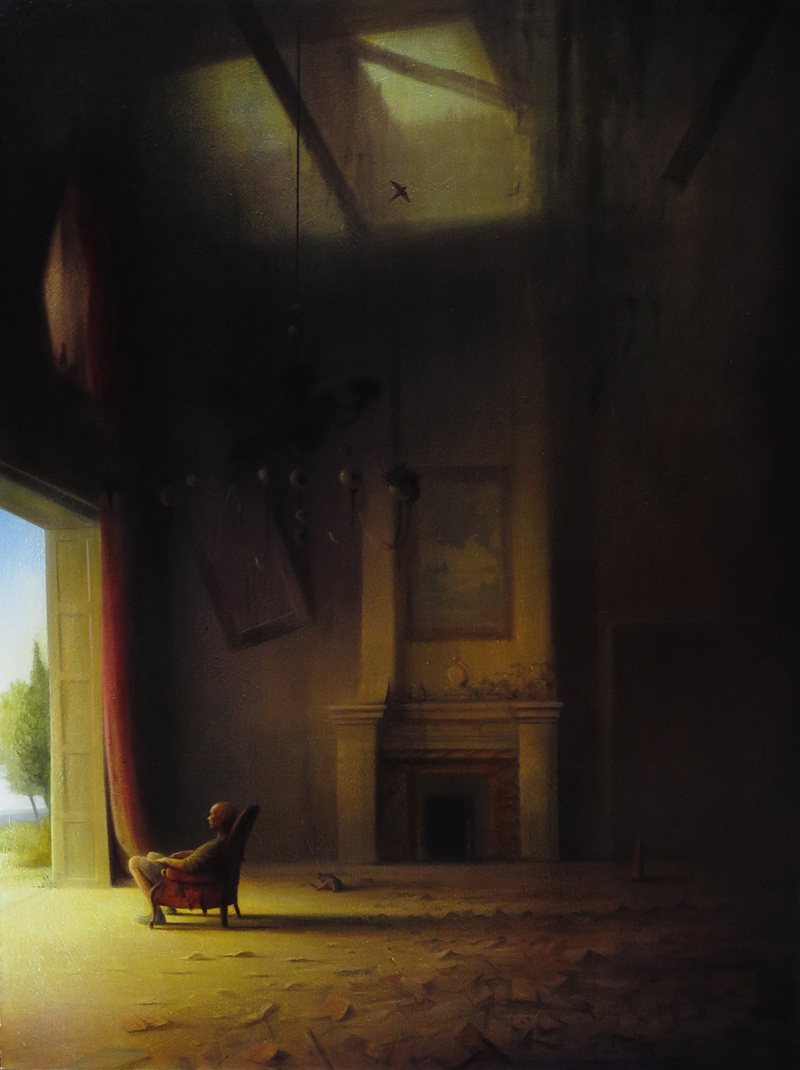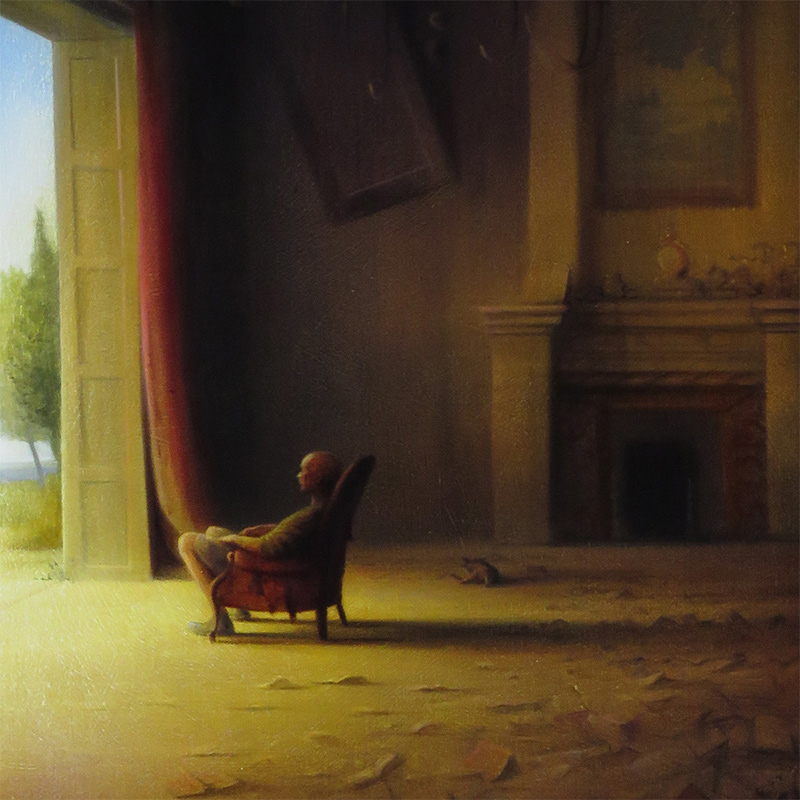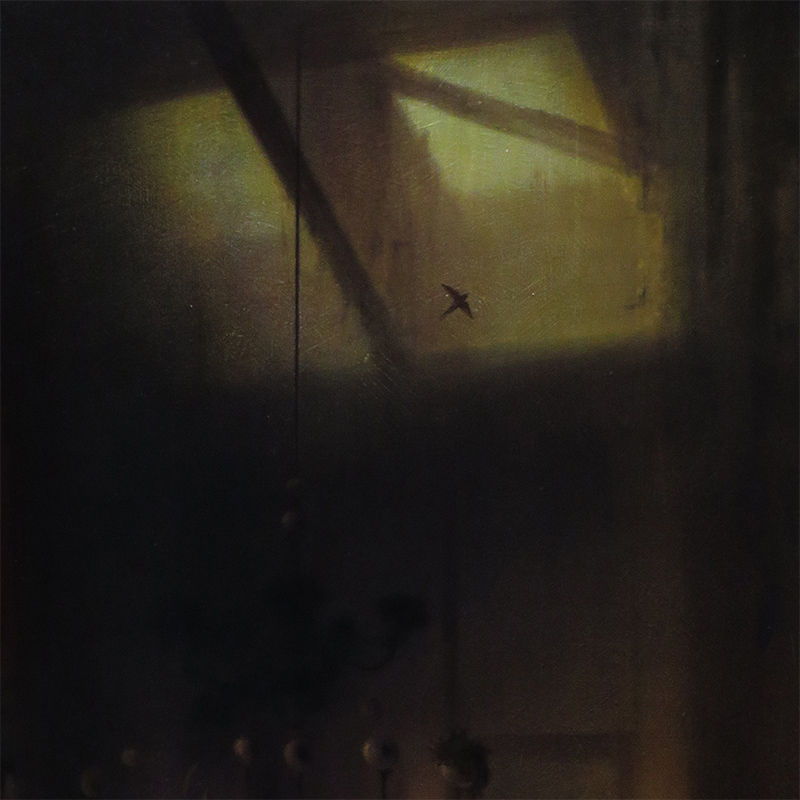Description
‘George Lost Many Years to Thought’ by Peter van Straten
Artist: Peter van Straten
Title: ‘George Lost Many Years to Thought’
Medium: Oil on Canvas
Dimensions: 47.2” x 35.4”
Framing: Unframed
Year: 2018
Artwork Will Ship From: South Africa
About the Aritst:
(Artist Bio)
The Artist.
Nothing ruins a grandiose sense of self like a hyperactive sense of irony. I am prevented therefore from uttering with any seriousness an ambition that is non-the-less heartfelt: to celebrate, with a single iconic image, each uniquely intriguing facet of human existence. This task would of course take many lifetimes, and while I might conceivably have many lives it is doubtful whether I would remember my task from one life to the next; becoming instead the postmaster at Wellington, then a bureaucrat in Bangladesh, followed by a housewife in Durban – each without the slightest interest in illustrating the human condition. For this reason I am driven by a deep sense of urgency in this lifetime – straining against the undertow of time to expand my understanding of the light bulb moments I am determined to illustrate. Luckily for me I find the story of Sisyphus more amusing than tragic, and my favourite word in the English language is Nympholepsy, which, to paraphrase the Oxford dictionary, is ecstasy or madness caused by pursuit of the unattainable.
If anything it is reassuring to know that one’s journeying will never be threatened by something as crass as destination, and it is pure bliss to paint that journey.
The physical palette.
Despite the indescribable pleasure I derive from painting I prefer to think of myself as an inventor of images rather than a painter, a distinction based in part on the fact that I will always love beautiful thoughts more than I could ever love beautiful things, and also because for me there is no more romantic vision of the working self than the image of the backyard inventor, tinkering late into the suburban night in his garage, on an invention whose secrecy is as thrilling as the inventor’s private and burning faith in its potential. A craftsman is merely a skilled manipulator of things as they are, while the inventor is committed to things as they could be – to a world improved.
Be this as it may, one has to choose a vehicle of expression, and I have fallen prey to an ever-deepening infatuation with the technique of glazing in oil paint.
Glazing in oils makes maximum use of the very thing that sets oil paints apart from other types of paint, namely opacity. When oil paint is applied in very thin “washes” light is still able to penetrate the paint and reach the white primer (or undercoat) to which the paint was first applied. This gives glazed images an unmistakeable glow, which, for anyone obsessed with light – whether physical or metaphysical – becomes the only conceivable mode of expression. The major difference between glazing technique, the way I use it, and regular oil technique is that with glazing, light is achieved by removing paint – repeatedly rubbing it away to keep re-exposing the white primer beneath, whereas in regular technique light is created by applying light colours with a brush. The latter technique celebrates the texture of paint and the dynamic movement of the brushstroke, while glazing sacrifices texture for luminescence and depth. Loss of textural interest in glazing is remedied by the constant re-exposure of the very first brush-strokes in the primer, by gentle sanding between successive layers of oil paint – essentially removing paint from the ridges of the brushstrokes in the undercoat. This also has the pleasing and slightly magical side effect of creating the illusion that the image is painted beneath the surface of the canvas. A further benefit of glazing in oils is the creation of compound colours which exist not because they were mixed on the palette, but which occur organically through the application of successive layers of opaque colour: olive green seen through cobalt blue, seen through burnt sienna, seen through purple madder, and so on, resulting in colours that cannot simply be mixed. My approach to painting is essentially cinematic. I envisage a scene, I decide on a location for that scene, then introduce “actors,” and because I am always working on top of a previous layer that has dried completely I am able to change my mind as often as I like without disturbing any of the decisions I have finalised before.
Perhaps one chooses a medium of expression that mirrors your style of being. In my life I circle around existential quandaries for years, revisiting and revisiting them from different angles, just as in painting I add new colours and details without disturbing the marks and colours that have gone before. Just as you cannot change a thought you had last week by thinking a different thought this week, so it is with glazing, which preserves all the steps of a thought process in oil, the way ancient bugs are preserved in amber.
The intellectual palette.
The question I get asked most regularly is: “where do you get your ideas?” and despite the frequency of the question I have never come up with a pleasingly concise or entertaining answer. But my heart, perplexed, responds with its own question: “With life being as rich an experience as it is, how on earth do you manage to avoid ideas!?” The wealth of subject matter with which life presents the mind is staggering: Consider the number of entertaining and thought-provoking images one could create about death, or the afterlife. About birth, about sex, about food, sport, or nature. About travel, about sleep, about dreams, about relationships between animals, or relationships between animals and people. About babies, about risk or adventure. About speed, about space, about weight, about gravity or its absence. About grace, about the past and about the future. About music, about madness, about treasure, silence, noise, fear, bliss or emptiness…
All that prevents one from being overwhelmed by this tsunami of potential is a carefully cultivated sense of humour and futility, and a necessarily constrained intellectual palette:
Tube one: Humour.
Nothing appals the earnest cognoscenti of fashionable culture more than humour in art. It is seen by the fearful intellectual as corrosive to profundity. Many religious people feel the same way about Truth: the more self-serious it is, the more profound it is. But no mind can dance freely without humour. Humour is what transforms the intellectual goose step into a foxtrot, or even better, total free form of movement. However, I do not deny that humour (like experimental dance) requires more intelligent control to succeed than other aspects of the intellectual palette. Humour is most beautiful and moving when it is blended with opposite or even counter-intuitive aspects of experience, such as loss, anger, emptiness or tragedy. The most intriguing images are those whose mystery defies verbal description, and it is the blending of unlikely “tones” from the intellectual palette that best achieve this. Neither darkness nor light is interesting enough on its own, and since we carry so many contradictory thoughts and emotions inside us, what choice is there but to embrace the simultaneity of contradictory factors in the human experience.
The very best images are utter simplicity derived from distillation of complexity, and you cannot have real complexity in content without engaging humour.
Tube two: Irony.
I do not know of a more difficult concept to describe than irony. My skills of articulation are defeated by it, but it is a defeat I cherish, and one that goes a long way to describing why I am so enamoured with irony in the first place. Modernism lacks irony. The modernist sensibility always achieves a great deal of flawed change in a short time because it is a world view uncluttered by ifs and buts. It is unsentimental, it is very male. How keenly then do I feel the privilege of having grown up in a Post Modernist milieu. A milieu in which one can take one’s work seriously without having to take oneself seriously! An altogether more feminine environment in which one can invent questions with the same enjoyment as answers. And because you are not trying to prove your contempt for the past you are free to experiment more joyously with the future. One example is kitsch. I sometimes think that my generation is the first to broadly display an ironic enjoyment of kitsch. Consider the art of Tretchikoff, who, despite selling millions of prints world-wide was summarily dismissed by his contemporaries because his work was unquestionably kitsch. Even today few regard his work as anything other than kitsch, and yet his work is undergoing a renaissance of appreciation – not despite its being kitsch, but because it is kitsch! My generation is enjoying it ironically! A triumph for Kitsch, a triumph for the post-modernist world view, and more than anything, a triumph for irony.
I have a dread of boredom and suffer therefore from a degree of mental restlessness that results in my always wanting to distort and subvert. Indeed for me the greatest intellectual beauty lies in the subverted subversion. A position that inevitably leads back to craft, because craft is so old-fashioned.
I am playing mind games, but I am also playing spiritual games, and I am doing it all with reverence, and the whimsy that results from a deep sense of futility, entwined with love.
Tube three: Spirituality.
Pleasingly, spirituality is yet another element feared by cultural intelligentsia.
No doubt spirituality is as dangerous as humour or kitsch and demands the subtlest expression if one wants to avoid any accidental resonance with the vast (and charmingly un-ironic) plethora of new-age spiritual imagery with which world is flooded. And yet what an unfathomably rich source of material is the spiritual ! It is a continent on which anything is possible, and a place where connection occurs on a far deeper level than the merely mental. It is a continent that has been explored and described by some of the world’s most beautiful minds, its languages translated into the language of its neighbouring continent, psychoanalysis, by the likes of Jung. No mind on earth, no matter how large or arrogant, is up to the task of understanding through thought alone the shape and design of life.
Tube four: Responsibility.
Many people think they have a responsibility towards artists, whose only responsibility on the other hand, is self expression. This is bizarre. I think that artists, like politicians, or spiritual leaders, or any other thought shapers, would benefit from a heightened sense of responsibility.
The Fine Arts is the only sphere of human activity that is absolutely free of rules. This is perhaps its greatest value, and greatest flaw. Very few people can grow to their full potential in a “space” without boundaries, however enjoyable that space may be to begin with. The result is at all times a jaw-droppingly self-indulgent avant garde, that cannot be more beautifully described than by the tale of the “Emperor’s new clothes.” In this context there is tremendous subversive appeal to the notion of advancing responsibility in the arts. Every absurdist atom of my being pulls towards this Utopian ideal. But of course it is a fool who expects of others something he should simply demand of himself.
For my part I only want to make images that can “do work” in the world, like new words for an existing language. I have no interest in portraying aspects of my own life, not only because I deeply cherish my privacy, but because intellectually I simply can’t be interested in something as random or mathematically unlikely as “myself”. In fact the very notion of “I” seems increasingly absurd to me. It is a belief system of dubious merit, and no more really than GPS positioning for spirits in the material world. And so my process of elimination becomes ever more rigorous: I reject more and more of my ideas for paintings as my eyes shift focus from the personal onto the permanent, and the universal. Scouting for parts of visual language I feel – but do not know for sure – are altogether missing until I have the privilege of expressing them.
What I paint is increasingly informed by what I don’t.
The four drivers:
Longing.
Nothing propels my work forward more than longing does. I yearn for states of consciousness I left behind in the process of my acclimatization to an adult mode of being. I have instinctively fought against such acclimatization. The result of course is loneliness, but an absolutely crucial loneliness, that insists on the rediscovery of, and reconnection with, a particular kind of beauty for which no one else on earth bears the particular responsibility of expression.
Alchemy.
The lesson of Zen tells us that the mundane is the magical inadequately perceived. But it is usually true that the act of extracting the transcendent essence from the mundane requires overt spiritual effort, or focus of the intellect or imagination – or all three combined. There is nothing more satisfying than alchemy to compare to the process of making art. A heap of materials, consisting of planks, canvas, staples, turpentine, oil, tubes of paint and brushes are transformed into an image capable of changing minds.
Transcendence.
Some feel a profound and mysterious presence beneath this reality’s porous surfaces. A sense that this world is supported by parallel worlds from which transcendence might seep – through contemplation, transcendent experience, or art. A sense that anything on earth, however mundane or apparently inanimate could be “switched on” (to use the 60’s phrase) if the person seeing it was “switched on,” an experience shared and understood by a small but very wide group of people, from aboriginal priests to experimental western drug takers or the mentally ill. I for one cannot live without believing in the potential of transcendence. I have to believe there is more than my senses sense, or I will go mad with the claustrophobia that comes from contemplating a purely physical world.
Mystery.
Science and Religion believe they are at opposite poles of the knowledge spectrum, but amusingly share one attribute: they both abhor mystery. Every day scientists all over the world work hard to overcome the mysteries that plague them, and every day the religious sooth themselves or try to persuade others with dearly held answers to the greatest existential mysteries.
But without mystery there would be no point to being. It is a privilege and an inspiration to live in a mysterious world, and a prison to live in a world addicted to answers. It is more exciting to discover a mystery than it is to discover the answer to a mystery. For me there is no greater joy as an artist than to create images whose meaning is a mystery even to myself.



